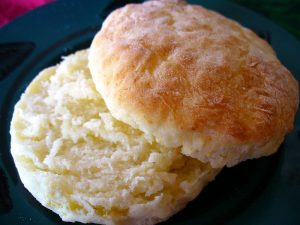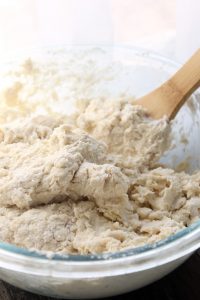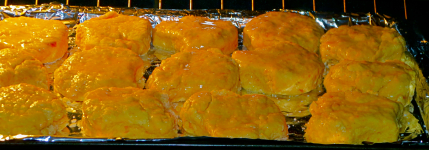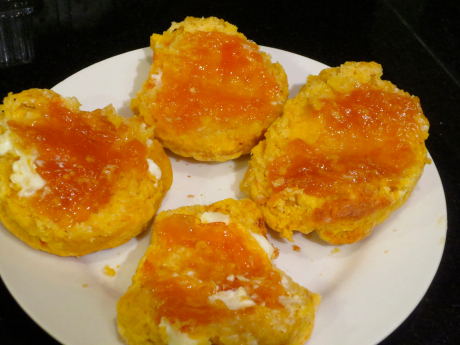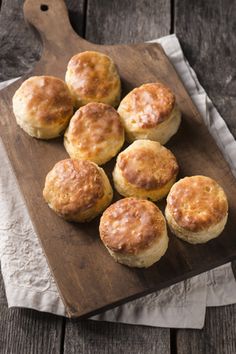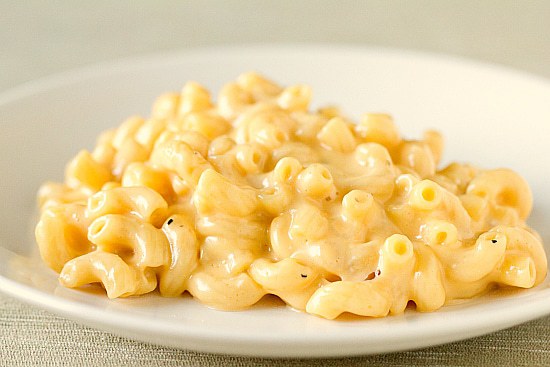I gotta be honest. I think I make killer biscuits. They are buttery, fluffy, and tender, perfect for biscuits and gravy, one of my favorite meals but only once in a while. As good as they are, every once in a while you need a change of pace. This is my change of pace. They still come out fluffy and tender, but with a little tang. I also like this Sour Cream Biscuits recipe because it makes what I would call a “short batch.” We are big fans of sour cream and think it belongs with even more foods than we usually see it on. It is a great invention.
All biscuits, what we might call American biscuits, to indicate something different than the British cookie, start with the same basic ingredients: flour, fat, salt, baking powder and milk. From there you can have lots of variations, both sweet and savory. Replace half of the milk with sour cream and you get these sour cream biscuits.
Preparation, Preheat, and Mix It Up
Preheat the oven to 425ºF, 220ºC, and make sure the rack is in the center position.
Another thing I like about this recipe is that you don’t need to combine the wet ingredients in a separate bowl. So, in a medium to a large mixing bowl, combine 1.25 cups all-purpose flour, 2 teaspoons of baking powder, 3/4 teaspoon salt, and 1/8 teaspoon baking soda. Just stir them all together so each ingredient is evenly distributed.
Cut up 3 tablespoons of shortening in small pieces. I like to use butter-flavored shortening to give it a more buttery taste. I prefer to use shortening rather than butter because it’s easier to use. Using the tips of your fingers, cut the shortening into the flour until the flour mixture looks crumbly.
Now, the wet ingredients, 1/3 cup milk and 1/3 cup sour cream, are stirred into the mixture. Keep stirring until the flour is incorporated and a wet dough comes together.
Work It, Bake It, Enjoy It
Create a clean, hard surface, make sure it’s dry, and sprinkle flour in the center of the work area. Turn out the dough from the bowl onto the work surface and pull all the pieces of dough together. Knead the dough ten times, just enough to bring the dough into a cohesive ball.
You can roll the dough into a rectangle about an inch thick. I like to just press it into the right shape and thickness.
Prepare a baking sheet with a baking mat, if you have one.
Using a bench scraper or sharp knife, cut the dough into six squares. You can also use a regular biscuit cutter, but that last one made up of scraps will be tough. Personally, I don’t mind square biscuits. No dough is wasted that way. Lay the six biscuits on a baking sheet.
Bake in the preheated oven until the biscuits are lightly browned, about 10 minutes.
Even with just butter, these biscuits are extremely tender and melt in your mouth. Add a little jam or jelly and it goes from a side to a delicious treat. These are easy and quick enough to make almost any morning special.
Extra Credit: Make Your Own
You might have noticed in the above recipe we used both baking powder and baking soda. This differs from my usual recipe but it is necessary because this is a wet dough and will need a little extra help in rising. The sour cream retains more moisture than just the liquid.
There are countless recipes for biscuits. Some use shortening, some use butter. Some are “wet” doughs and some are drier. Some biscuit makers think precise measurements are absolutely necessary. Others say precision is less important than technique. In any case, biscuits are very forgiving and can still taste good no matter the method used. That means you can feel free to experiment.
In my regular biscuit recipe, I use a splash of white vinegar to “sour” the milk, adding more acid to the mixture which will help the baking powder make the biscuits fluffy. Sour cream or buttermilk does the same thing.
More About Biscuits
All biscuit recipes share some common elements. Simple pantry ingredients: flour, salt, shortening or butter, baking powder (a mixture of baking soda, cream of tartar and corn starch), and milk. Some recipes add in an egg for added richness.
They also all share a common set of procedures:
1) Preheat the oven
2) Mix together the dry ingredients
3) “Cut” in fat as evenly as possible
4) Mix together the wet ingredients and combine with the dry ingredients
5) Mix to form a loose dough and turn out onto a floured work area
6) Roll out the dough and cut it into biscuits
7) Bake until golden brown
That gives you quite a bit of leeway over both the ingredients and the process. Take for example the “cutting in” step. If you are using shortening, just cut it into small pieces and then just gently use your fingers. Be careful not to melt the shortening with your body heat. You can use a “cutting” tool but it doesn’t work much better than an ordinary fork. If you use butter, you can use softened butter, or you can stick it into the freezer for a few minutes and then use a box grater to shred the butter into the dry ingredients.
Knead the dough about ten times. The number may seem important and you find recipes that put great emphasis on the number of times you knead the dough. The idea is to knead it enough to bring the dough together but not enough to build gluten. Flatten the ball of dough, fold it in half, press it down, and repeat it nine more times turning it a quarter turn each time.
How much baking powder is used does not seem to make a big difference in taste, although some say the higher amount of baking powder will make the biscuits taste like chemicals. The best ratio seems to be about 1.5 teaspoons of baking powder per 2 cups of flour. Less baking powder gives you a denser more moist biscuit. If your baking powder is a little old, you might want to up that ratio to 1 teaspoon to 1 cup of flour.
Another ratio to use is the amount of liquid to dry ingredients. Drier doughs seem to give you flakier biscuits than wetter dough. One cup of milk per two cups of flour seems to work best.
Butter, Shortening or Margarine?
Many recipes call for using butter. This one used butter-flavored shortening. And a lot of people seem to like the taste of margarine as the fat in their biscuits. I think margarine has other issues, like trans fats, which would not put it at the top of my list. Most likely, those are people who grew up with margarine. If I didn’t use shortening, I would use butter. I don’t like margarine. But which you use is your choice, they will still come out worth the effort.
Conclusion
As I said earlier, biscuits are a very forgiving baked good. Variations in measurements and ingredients don’t seem to make much difference. You could easily add fruit, spices, sweetness or acid and still have a good biscuit.
